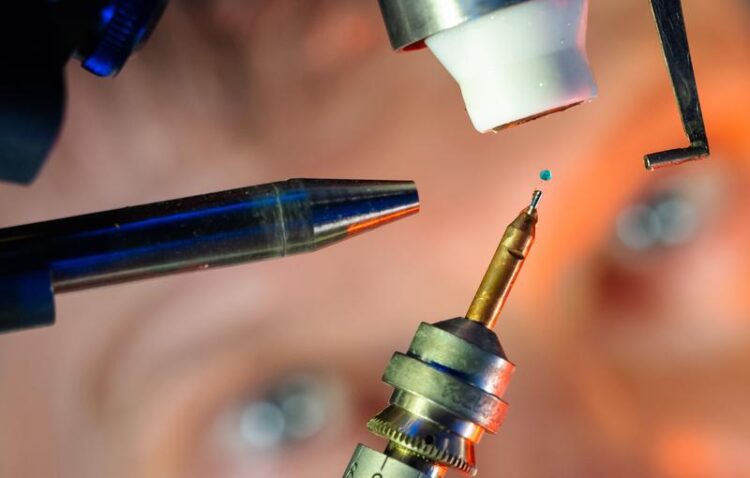Teamwork in a molecule

Dr. Helmar Görls untersucht mit einem Röntendiffraktometer aus neuen Verbindungen gezüchtete Einkristalle am Institut für Anorganische und Analytische Chemie an der Friedrich-Schiller-Universität Jena.
Jens Meyer/Universität Jena
Chemists at the University of Jena harness synergy effect of gallium
Chemists at Friedrich Schiller University Jena have demonstrated the value of “teamwork” by successfully harnessing the interaction between two gallium atoms in a novel compound to split the particularly strong bond between fluorine and carbon. The gallium compound is also cheaper and more environmentally friendly than conventional alternatives.
Sustainable and inexpensive
“Such reactions are usually carried out using transition metals, such as nickel or iridium,” explains Prof. Robert Kretschmer, Junior Professor of Inorganic Chemistry at the University of Jena, whose work has been published in the prestigious Journal of the American Chemical Society. “However, transition metals are expensive and harmful to the environment, both when they are mined and when they are used. Therefore, we are trying to find better alternatives.” That two metals can do more than one is already known in the case of transition metals. “However, there has been hardly any research on the more sustainable main-group metals of the periodic table,” Kretschmer adds.
Hand in hand
“Our compound contains two chemically identical gallium atoms,” says Kretschmer. “In tests with a series of fluorine-containing hydrocarbon compounds, we saw that these two atoms together are capable of removing a fluorine atom. Using X-ray structure analysis, we were able to prove that one gallium atom binds the fluorine and the second binds the other part of the hydrocarbon compound.” This is the first step needed for catalysis.
“Now that this step has been achieved, we can consider how to develop this concept further,” explains Kretschmer. “It would of course be desirable if, at the end, the reaction could be continued to achieve a complete catalytic cycle.” However, this will probably involve a different metal. Kretschmer notes: “Gallium as an element was a first step here. Our goal is ultimately to harness the metal that occurs most frequently on earth: aluminium.”
Wissenschaftliche Ansprechpartner:
Prof. Robert Kretschmer
Junior Professorship (Tenure Track) Inorganic Chemistry of Catalysis
Institute for Inorganic and Analytical Chemistry of Friedrich Schiller University Jena
Humboldtstraße 8
07743 Jena, Germany
Tel.: +49 (0)3641 / 948 911
E-mail: robert.kretschmer[at]uni-jena.de
Originalpublikation:
Oleksandr Kysliak, Helmar Görls and Robert Kretschmer, “Cooperative Bond Activation by a Bimetallic Main-Group Complex”, Journal of the American Chemical Society, 2021, (143:1), 142–148
https://pubs.acs.org/doi/10.1021/jacs.0c12166
Weitere Informationen:
Media Contact
All latest news from the category: Life Sciences and Chemistry
Articles and reports from the Life Sciences and chemistry area deal with applied and basic research into modern biology, chemistry and human medicine.
Valuable information can be found on a range of life sciences fields including bacteriology, biochemistry, bionics, bioinformatics, biophysics, biotechnology, genetics, geobotany, human biology, marine biology, microbiology, molecular biology, cellular biology, zoology, bioinorganic chemistry, microchemistry and environmental chemistry.
Newest articles

Hyperspectral imaging lidar system achieves remote plastic identification
New technology could remotely identify various types of plastics, offering a valuable tool for future monitoring and analysis of oceanic plastic pollution. Researchers have developed a new hyperspectral Raman imaging…

SwRI awarded $26 million to develop NOAA magnetometers
SW-MAG data will help NOAA predict, mitigate the effects of space weather. NASA and the National Oceanic and Atmospheric Administration (NOAA) recently awarded Southwest Research Institute a $26 million contract…

Protein that helps cancer cells dodge CAR T cell therapy
Discovery could lead to new treatments for blood cancer patients currently facing limited options. Scientists at City of Hope®, one of the largest and most advanced cancer research and treatment…



